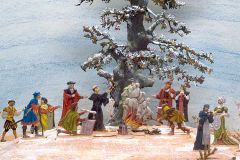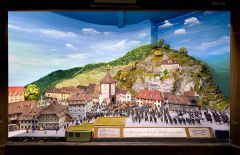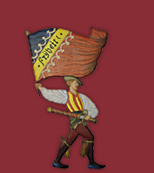
Our topics: history to look at
Peasants' War and Reformation
From 1524 to 1526 Southwest Germany saw the uprising of the “common man” against his secular and clerical masters. Several dioramas illustrate the revolts around Freiburg.
One recalls the Black Forest peasants´ gang under the commander Hans Müller of Bulgenbach on the march towards Freiburg. Another diorama depicts the peasants´ army crossing the river Wutach at the foot of Hohenlupfen castle. Life during the late Middle Ages is shown in its various colorful aspects: castles and villages, burghers and peasants, agriculture and harvest, the cattle and much more.
>> corresponding dioramas
 Three dioramas refer to the Reformation. The first one is showing Martin Luther and his supporters burning the papal bull of excommunication, the following one pictures Luther's arrival at the Imperial Diet of Worms 1521. The last one depicts the simulated kidnapping of Luther on his return from Worms.
Three dioramas refer to the Reformation. The first one is showing Martin Luther and his supporters burning the papal bull of excommunication, the following one pictures Luther's arrival at the Imperial Diet of Worms 1521. The last one depicts the simulated kidnapping of Luther on his return from Worms.
>> corresponding dioramas
Social and daily life history
Some of the dioramas present daily life-topics: gem-cutters are trimming crystals in their workshops at Freiburg´s suburb along the industrial canal; a procession in traditional clothing is on its way to the chapel; three women sentenced as witches are running the gauntlet to the execution stake near the river Dreisam.
>> corresponding dioramas
Revolution
 The large diorama of the Baden Revolution 1848/49 is a matter of particular importance to Freiburg, where a decisive battle took place at the foot of the Swabian Gate. The showcase spanning three to one meters reconstructs the old city in a 1:100 scale. The overview reaches from the battle at the barricade in front of the Swabian Gate to the industrial canal along the “Insel” (isle) and “Gerberau” (tanner's lane).
The large diorama of the Baden Revolution 1848/49 is a matter of particular importance to Freiburg, where a decisive battle took place at the foot of the Swabian Gate. The showcase spanning three to one meters reconstructs the old city in a 1:100 scale. The overview reaches from the battle at the barricade in front of the Swabian Gate to the industrial canal along the “Insel” (isle) and “Gerberau” (tanner's lane).
>> corresponding dioramas
Various topics
Several dioramas on loan to our museum are well worth seeing: numerous models of castles in Southwest Germany and a forest habitat. Some more highlights are taken from the field of art and culture as well as from the sphere of myth and fairytales. >> corresponding dioramas



